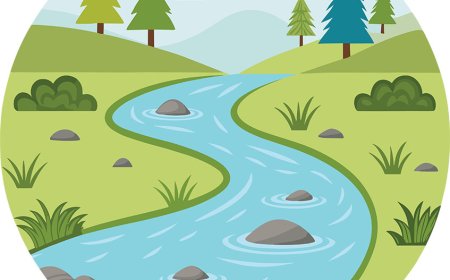Plate Tectonics Explained for Students | Earth’s Moving Plates
Learn how Earth’s tectonic plates move, create mountains, earthquakes, and volcanoes. Includes fun facts, quiz, and vocabular
🌟 Introduction
Earth's surface may look solid and unmoving, but it is really made of giant puzzle pieces called tectonic plates. These plates form the outer shell of our planet and float slowly on the softer layer beneath them. Their movement reshapes Earth's surface over millions of years, creating mountains, opening oceans, and causing earthquakes and volcanoes. This powerful idea, called plate tectonics, helps scientists explain how continents drift, why earthquakes happen where they do, and how volcanoes form. Understanding plate tectonics allows us to see Earth as a constantly changing and dynamic planet.
🔍 What is Plate Tectonics?
Plate Tectonics is the theory that Earth's lithosphere (the crust and upper mantle) is divided into large plates that move slowly on the softer asthenosphere beneath them.
There are three main types of plate boundaries:
-
Divergent boundaries: Plates move apart, and new crust forms as magma rises (e.g., Mid-Atlantic Ridge).
-
Convergent boundaries: Plates collide, forming mountains (Himalayas) or subduction zones with volcanoes (Andes).
-
Transform boundaries: Plates slide past each other, creating earthquakes (San Andreas Fault).
This movement is driven by heat and convection currents deep inside Earth's mantle.
🌍 Why is Plate Tectonics Important?
-
Explains Earth's Surface: Mountains, ocean trenches, islands, and valleys all form because of plate movements.
-
Predicting Hazards: Knowing where plates meet helps us understand where earthquakes and volcanoes are most likely to happen.
-
Resources: Plate boundaries help locate minerals, geothermal energy, and oil deposits.
-
Earth's History: Plate tectonics explains how continents were once joined in Pangaea and slowly drifted to their current positions.
🧪 Everyday Examples
-
Earthquake drills in California are needed because the San Andreas Fault is a transform plate boundary.
-
The Himalayas continue to grow taller as the Indian Plate pushes into the Eurasian Plate.
-
Iceland is split by a divergent boundary, where new crust is constantly forming.
-
Volcanoes in the Andes Mountains are fueled by subduction as the Nazca Plate dives beneath South America.
✨ Fun Facts
-
Tectonic plates move at about the same speed as fingernails grow.
-
The Pacific Plate is the largest plate, covering most of the Pacific Ocean.
-
Without plate tectonics, Earth would likely be flat and covered in water!
-
Scientists only accepted plate tectonics as a unifying theory in the 1960s.
📌 Key Takeaways
-
Plate tectonics explains how Earth's surface is shaped and reshaped.
-
Plates move at divergent, convergent, and transform boundaries.
-
This movement builds mountains, creates earthquakes, and fuels volcanoes.
-
Plate tectonics is one of the most important ideas in geology.
🐾 Kid-Friendly Summary
Earth's crust is made of giant puzzle pieces called plates. They move very slowly, but when they bump, pull apart, or slide, they create mountains, volcanoes, and earthquakes.
📚 Vocabulary Words
-
Lithosphere: The rigid outer layer of Earth, made of crust and upper mantle.
-
Asthenosphere: The softer layer below the lithosphere that plates move on.
-
Convection Currents: Heat-driven movements in the mantle that push plates.
-
Plate Boundary: Where two plates meet.
-
Divergent Boundary: Where plates pull apart.
-
Convergent Boundary: Where plates collide.
-
Transform Boundary: Where plates slide past each other.
-
Subduction Zone: Place where one plate sinks under another.
-
Pangaea: Supercontinent that existed millions of years ago.
-
Fault: A crack in Earth's crust where movement happens.
🧠 Interactive Quiz on Plate Tectonics
- Plate tectonics is the theory that
A. The sky moves
B. Earth’s plates move and shape the surface
Answer: B - Divergent boundaries are where plates
A. Move apart
B. Slide past
Answer: A - The Himalayas formed because
A. Plates pulled apart
B. Plates collided
Answer: B - The San Andreas Fault is an example of
A. Transform boundary
B. Convergent boundary
Answer: A - Pangaea was
A. A type of mineral
B. A supercontinent
Answer: B


















































